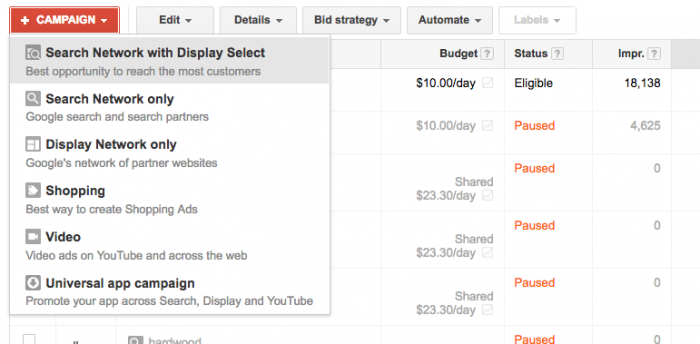If words like “domain,” “query,” and “crawler” make you think more sci-fi than Google, you may be a newbie to the digital marketing game like me. Fortunately, we no longer need to sift through technobabble to become informed about SEO, PPC, and those other geeky acronyms that make up digital marketing.
What is Digital Marketing?
If you have already done a basic Google search, you have most likely already come across definitions of digital marketing similar to this one from Hubspot:
Digital Marketing: any form of marketing that exists online.
While you really can’t get more straightforward than that, it doesn’t tell you all that much. If you want to go a little further down the rabbit hole and open your mind to the potential of the online marketing world, it is important to distinguish that digital marketing is not simply a web-based form of traditional marketing. Actually, let’s take a step back for a moment to understand how the web opened up an entirely new marketing frontier.
The dawning of the internet has not only made digital marketing possible, it’s made it necessary. Even though time spent on the internet is steadily rising (with people browsing for an average of five hours a day just in the US), marketing is no longer limited to traditional efforts like TV commercials, radio, magazine ads, billboards, and the like.
While these forms of advertising still inundate our lives, search engines like Google are evolving to make search results more relevant to what you are looking for. This provides marketing tools that meet users where they are – online.
Before I begin to explain those tools, let’s have some fun as we stitch this together. Let me suggest a business—I like to use my imagination, so let’s say you’re a hedgehog dentist—how could you fail, right? Well, even though you graduated the top of your class in hedgehog dentistry and have been around for a while, surprisingly, the clients are just not pouring in the way you expected them to.
It’s 2017 so let’s be real, you probably already have a website. Even so, as with many business owners, your current online presence still doesn’t seem to be enough. You are in search of a better way to increase visits to your site that will lead to leads, inquiries, and appointments.
Truthfully, in the online world, (as in life itself) just “existing” is not enough. That being the case, how can digital marketing help you leverage the World Wide Web to let the hedgehog people of America know you are there for their tiny dental maladies?
Put yourself in the shoes of your prospective clientele. Using your typical Google habits, when you type in “hedgehog dentistry,” do you think it is likely you are going to scroll to the third page of results? How often do you even scroll to the end results of the first page? Like many users in most cases, you are likely to click on the results in the first page. So naturally, when someone searches “hedgehog dentistry,” this is where you want your clinic to appear.
How do you get there, you ask? While at first, it may seem like only a privileged few are magically selected by the Google gods, there is a method behind the madness. With the right digital marketing behavior, cleanliness really is close to godliness and you can move up the ranks honestly. You can use both paid (usually PPC, which we will get to in a minute) and organic SEO strategies to advertise yourself online. Many experts recommend a healthy combination of both.
This leads into a whole new world of topics. For your purposes—even if you plan on farming out your digital marketing needs to experts—it is important to understand the basics of digital marketing to discern between legitimately good SEO techniques that will support your business, and the bad SEO techniques, which might irreparably harm your brand image and rankings in the long run. To learn more about avoiding bad SEO, check out this helpful article.
SEO (Search Engine Optimization)
Let’s start with Search Engine Optimization. SEO is how you rise to the top of Google’s rankings naturally and is an essential component of your digital marketing efforts. As soon as you publish something on the internet, robots, also called “crawlers” are notified immediately. These crawlers visit your pages to gather information on your content to report to Google. Google has a multitude of algorithms which use the crawlers’ signals to rank the pages. The algorithms use the information gathered to measure factors about your content, such as user experience, relevance, originality, trustworthiness, and authority. Essentially, Google’s goal is to provide users with exactly what they are looking for when they type in a keyword or key-phrase into the search bar. The algorithms are intended to filter misleading, spammy, low-grade content, malware, or anything otherwise technically unsound.
Obviously, Google’s crawlers are not people, so your site should be constructed in such a way that they can predict in order to easily navigate and report to Google. This is done by making your site intelligible for Google’s robots, allowing Google to understand and index your website content. Otherwise, it does not matter if your site is visually appealing and contains what you determine to be useful content. If you are not following SEO protocol, the crawlers will report data that will signal Google to assign a low rank to your content, which will leave it buried in the search results.
PPC (Pay-per-click)
Moving on from organic systems, PPC is the primary paid component of digital marketing. Essentially this is a model where advertisers will bid for placement (usually at the top, or on the right-hand side as pictured below) on what is referred to as SERPs (search engine results pages) for trending words or keywords associated with your business or brand. The advertiser then pays the ad distributor every time their ad is clicked on. While the most popular PPC platforms are Google AdWords and Bing Ads, Facebook is also very popular for paid ads.

Google AdWords is the go-to platform to strategically manage your paid search campaign. AdWords provides you with visibility even when you don’t appear at the top of organic search results. With various types of campaigns to choose, advertisers have the flexibility to create unique goals like increasing sales, generating leads and promoting brand awareness. Advertisers conduct extensive research to develop an effective strategy to determine then bid on keywords most valuable to their campaign and avoid those that might have a negative ROI. A huge benefit to AdWords is the ability to decide how much you are willing to spend on keywords and often your ad appears. 
Measuring the success of your paid search campaign is essential, as well as targeting your ads to your market by region, age, gender, or even on other sites related to yours. All things considered, PPC is all about relevance. When users are searching for specific products and services at any given time advertisers have the ability to display a targeted ad at the moment the search is occurring.
Experienced advertisers would argue that there’s no one way to create successful PPC ads. However, once you have a solid understanding of all the features and benefits of paid search ads, there are countless experiments for you to test – guaranteed to maximize your reach and potential.
Pro Tip: ALWAYS conduct research on your core audience. This ensures you display ads most relevant to the right people. And keep it simple, use a well thought out call-to-action.
Inbound vs. Outbound Marketing
 The introduction to the digital realm caused a fascinating split in approaches to marketing. Historically, advertisers have benefitted from fighting for consumers’ attention with inflated promises, instant gratification, and spectacle that often relies on the outrageous. On the internet, this traditional “push” method takes the form of pop-up ads and “clickbait,” or may follow you around online with “remarketing” and other aggressive tactics. However, consumers are always becoming more skilled at avoiding these ads because they can be annoying and misleading. Frankly, they just generally do not collaborate well with Google’s mission to provide the precise, seamless experience users seek.
The introduction to the digital realm caused a fascinating split in approaches to marketing. Historically, advertisers have benefitted from fighting for consumers’ attention with inflated promises, instant gratification, and spectacle that often relies on the outrageous. On the internet, this traditional “push” method takes the form of pop-up ads and “clickbait,” or may follow you around online with “remarketing” and other aggressive tactics. However, consumers are always becoming more skilled at avoiding these ads because they can be annoying and misleading. Frankly, they just generally do not collaborate well with Google’s mission to provide the precise, seamless experience users seek.
In contrast, inbound marketing seeks to earn rather than fight for your attention through an engaging, positive, valuable online experience—largely through something called “content marketing.”
In short, while outbound or traditional efforts can be pushy or even obnoxious, the inbound approach will provide useful content to address the problem that will later draw your prospect to seek out your product or service. Inbound marketing is possible because of the access data provided through digital tools, such as Google Analytics. In fact, inbound marketing, content marketing, and digital marketing are so intertwined that they are often referred to synonymously.
Content Marketing
Instead of pitching your product or services with inflated promises and distracting gimmicks, you can use content marketing to develop a trustworthy relationship through helpful, valuable, branded content that will motivate prospects to seek out your business.
Social media may immediately come to mind, but content marketing does not end with blogs, Tweets, Facebook and YouTube content. While these outlets make up a large piece of your content strategy, your efforts should not end here. Social media marketing alone will not take you to the top ranks of a Google search. For more information about the relationship between social media and SEO, check out this helpful article.
Now, an example of effective content marketing: I enjoy this video which actually spoofs traditional infomercials. It went viral for its shareable, humorous content that may just motivate you to go out and adopt from their animal shelter.
While it may often seem like fun and games, according to these statistics, per dollar spent, content marketing has actually been shown to drive growth in traffic and leads by as much as three times more than traditional strategies. Here are a few more examples of content marketing in action.
Branding through Content
If marketing handles advertising, content affects your brand. So how does this relate to the inbound marketing approach? When it comes to content, brand perception should be on both your immediate and long-term radar. This is the side of your business that is owned by your customers. No matter what business or service you offer, how the public perceives your business directly influences the reception of your message. This is where a more patient, the polite inbound approach works in your favor for the long term. Quality businesses should incorporate that quality in their advertising strategies—think of it as giving a sample of the value of your product or service in the form of useful information.
While growing up inundated with outbound advertisements may make this strategy counterintuitive at first, it does promise a more long-term investment in brand perception and reputation—arguably one of your business’ most valuable assets. So rather than try to quick-fix stagnating business, it is important to think longer-term and resist the temptation of using bad digital marketing strategies that cut technical corners to lure traffic to your site. Not only do you risk damaging brand perception by misleading your prospects, once Google catches on to your shenanigans (it always does), your site will probably be penalized, and recovering your ranking can be a long and expensive road. For more information, check out this article.
Email Marketing
Email has been around longer than Google and is still a powerful digital marketing outlet. In fact, email marketing is more effective for customer acquisition than Facebook or Twitter. Surprised? Even without the bells and whistles available through social media, email generates the highest ROI for marketers.
Ready to get started?
Whether you consider your curiosity satisfied or are serious about learning more about digital marketing, I hope that I have cleared up some of the mystery around the subject for you. If you want to learn more, below you’ll find listed some of our other posts that may be helpful to you as you advance in your knowledge of digital marketing.


